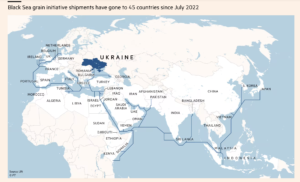Bloomberg's Clarice Couto reported this past Friday that "a surprising tax change in agriculture powerhouse Brazil has the potential to make soy grown in the world’s largest bean exporter less…
More Heavy Rains Expected in China’s “Grain Basket,” While Black Sea Viewed as “Increasingly Dangerous Cauldron” of Tension
Bloomberg writer Hallie Gu reported today that, “China’s northeastern grain basket is bracing for more rains and flooding brought on by Typhoon Khanun, as producers struggle to recover from the impact of an earlier storm that ravaged farmland and destroyed crops.
Heavy rains are expected in parts of China’s northeast that includes the provinces of Heilongjiang, Jilin and Liaoning, and the Inner Mongolia region, in the next few days. Local governments are making urgent preparations to secure agriculture production and minimize crop losses in an area that produces almost 30% of China’s grain.
“Although the full picture of the damage sustained so far isn’t clear, recent flooding has inundated corn and rice crops, as well as wrecking greenhouses and livestock pens, according to a slew of notices released by local agriculture bureaus this week.”
“The government in Heilongjiang warned in an emergency notice on Tuesday of a ‘hard battle‘ to ensure agriculture production,” the Bloomberg article said.
Meanwhile, Financial Times writers Shotaro Tani, Harry Dempsey and Isobel Koshiw reported yesterday that, “The collapse of the Black Sea grain deal and Russian strikes on Ukrainian infrastructure have renewed the threat to the world’s food security from disrupted supplies, as Moscow pushes for a greater share of global grain exports.”

The FT article indicated that, “This escalation ‘heightens risk and triggers uncertainty,’ said Arif Husain, chief economist at the UN World Food Programme.
‘A single mis-step by either party will have disastrous consequences simply because there is no immediate substitute for all the grain exported by Russia and Ukraine from the Black Sea,’ he said.
The FT article noted that, “‘Next year Ukrainian farmers will plant far less, given the circumstances,’ [Michael Magdovitz, senior commodity analyst at Rabobank] added. ‘How that will affect the international market remains to be seen, but it should elevate the long-term floor for prices because you are removing a cheap supplier from the market.'”

Likewise, Marc Santora and Steven Erlanger reported on the front page of yesterday’s New York Times that, “Bordered by Ukraine, Russia and three NATO countries, but sometimes overlooked in the war, the Black Sea has become an increasingly dangerous cauldron of military and geopolitical tensions, following Moscow’s decision last month to end a deal ensuring the safe passage of Ukrainian grain.

“Removed from the fierce fighting on the front, the Black Sea nevertheless puts Russia and NATO countries in the kind of proximity that does not exist in other theaters of the war, like the defense of Kyiv or the battle for Bakhmut — increasing the risk of confrontation.”
“The battle for control of the sea could have implications for global energy markets and world food supplies,” the Times article said.
Bloomberg News reported today that, “Wheat edged higher in Asia — after falling the most in over a week on Wednesday — as traders weighed the risks to Black Sea exports.”

Elsewhere, Reuters writer Pavel Polityuk reported yesterday that, “Ukraine’s grain exports have totalled 2.76 million metric tons so far in the 2023/24 July-June season, Agriculture Ministry data showed on Wednesday.
“The ministry gave no comparative figures for the same date a year earlier but said the shipments were at 2.34 million tons as of Aug. 12, 2022.”
Also yesterday, Bloomberg writer Anuradha Raghu reported that, “Rice prices soared to the highest in almost 15 years in Asia on mounting concerns over global supplies as dry weather threatens production in Thailand and after top shipper India banned some exports.”

And New York Times writers Eshe Nelson, Ana Swanson and Jeanna Smialek reported today that, “As the rate of food price inflation eases in the United States and Europe, analysts are warning of a new era of volatility in global food prices, ushered in by a series of threats coming together in unprecedented ways.
“A combination of calamities — extreme weather, Russia’s targeting of grain supplies in Ukraine and some countries’ growing willingness to erect protectionist barriers to food trade — has left food supplies more vulnerable and less prepared to absorb any one disruption, analysts say.”







